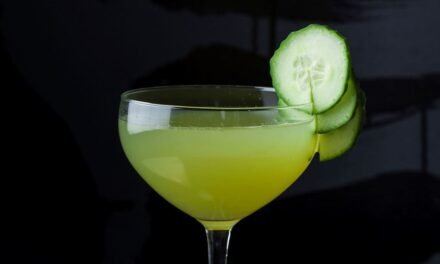Many Americans are unaware of cachaça even though it is the most popular distilled spirit in Brazil. An astonishing 175 million cases are produced each year, but most of it is consumed within the country; while no more than 10% is exported, the better versions are starting to turn up regularly in our bars and restaurants.
Cachaça is sometimes described as Brazilian rum. This is roughly true, since it is made from the juice of fresh sugar cane that is first fermented and then distilled. Some rums are made that way, but the majority are produced from molasses, a process which is cheaper and quicker. In both cases a clear distillate comes off the still, and may then be put into oak barrels for aging. Like rum, most cachaça is mass-produced in column stills, and the more interesting ones are hand-crafted in copper pot stills.
In this country, most of us who are familiar with cachaça have been introduced to it via the caipirinha, the national cocktail of Brazil. It is essentially a mojito without the mint leaves: You muddle several teaspoons of sugar with half a lime, add crushed ice, and pour in the cachaça. There are endless variations with fresh fruit, and your favorite fruit (or anything that’s handy) can be added for additional flavor. Traditionally the cheapest available cachaça was used in a caipirinha, but the practice is changing due to the trend toward more sophisticated palates and better-quality spirits.
At the top end of the scale, the best cachaça—like other spirits—is made in small batches, expensive and hard to find. They tend to be pale amber in color, the result of years of aging in Brazilian wood casks. Rochinha, which has been made on the same farm since 1902, comes in five or 12 year-old versions. GRM, which has quite a cult following, is said to resemble a premium anejo tequila. Toward the apex of the pyramid is Armazem Vieira; their Onix, a 16 year-old solera cachaça, easily sells for more than $100.
Premium cachaça really arrived in the United States with Leblon, a brand created in Brazil in 2005. The spirit is crafted by master distiller Gilles Merlet, and production hits all the quality criteria: hand-selected sugar cane, immediate pressing, long fermentation, pot-still distillation, triple filtration, and maturation in Cognac XO casks prior to final blending. Leblon can now be found in chain restaurants, upscale steak houses and cruise lines, and is spearheading the growth of cachaça in this country.
The nose of Leblon ($30) is clean, fragrant and floral, with overtones of citrus and hints of sweetness. In the mouth, the sweetness is nicely balanced with touches of pepper, and notes of candied citrus emerge in the mid palate and continue on the finish. This has more than enough character to sip on its own, or to drink with ice or a splash of water or soda. My instinct is that it would make a very intriguing Martini.
Leblon has recently launched a liqueur called Cedilla, made from Brazilian açai berries. The açai is a species of tree traditionally cultivated for hearts of palm. In recent years it has been celebrated for its berries, which supposedly promote weight loss and reverse the course of several diseases (none of this has ever been scientifically proven). To make Cedilla, Leblon has combined their cachaça with a maceration of hand-picked acai berries. The nose has a pleasant fruit punch quality, highlighted by aromas of black raspberry. The sweetness is prominent on entry (the sugar content isn’t listed, but being a liqueur we can assume it’s at least 12%), but gives way in the middle to mouthwatering flavors of crushed red berries and touches of baking spices. The finish is long, sweet and herbal. The website recommends substituting this for cassis or Chambord (in a Kir Royale), or for sweet vermouth (in a Negroni), and also lists a number of interesting cocktails.
RECIPES:
THE LEBLON CAIPIRINHA
2 oz. Leblon Cachaça
2 tsp. superfine sugar or 1 oz. simple syrup
½ lime, cut into wedges
Muddle the lime and sugar in a shaker. Fill the shaker with ice and add the cachaça. Shake vigorously and serve in a rocks glass; garnish with a lime wheel.
SALVADOR SLING
2 oz. Leblon Cachaça
1 oz. Cedilla
½ oz. fresh lime juice
½ oz. ginger liqueur
2 oz. pineapple juice
Dash of bitters
Combine all ingredients in a mixing glass, add ice, and shake vigorously. Strain into an ice-filled highball glass, and garnish with a pineapple slice or small flower.
ABOUT THE BOOK: Iconic Spirits: An Intoxicating History, by Mark Spivak, will be published in November by Lyons press (Globe Pequot). Writing in an engaging and appealing style, Spivak chronicles the untold tales of 12 spirits that changed the world and forged the cocktail culture. While some are categories and others are specific brans, they are “the best kinds of stories—the type a writer could never make up.”
Want to chime in? Follow this link and leave a comment:
http://www.iconicspirits.net/
Mark Spivak is an award-winning writer specializing in wine, spirits, food, restaurants and culinary travel. He was the wine writer for the Palm Beach Post from 1994-1999, and since 2001 has been the Wine and Spirits Editor for the Palm Beach Media Group, as well as the restaurant critic for Palm Beach Illustrated. His work has appeared in National Geographic Traveler, Robb Report, Ritz-Carlton, Continental, Art & Antiques, Newsmax, Dream of Italy and Arizona Highways. From 1999-2011 he hosted Uncorked! Radio, a highly successful wine talk show on the Palm Beach affiliate of National Public Radio.
Mark began writing Iconic Spirits after becoming fascinated with the untold stories behind the world’s greatest liquors. As a writer, he’s always searching for the unknown details that make his subject compelling and unique.
You can learn more about Mark at http://www.iconicspirits.net/index.htm
Available on Amazon
http://www.amazon.com/Iconic-
If you would like to submit a guest post on food, wine or travel to Where and What in the World, I would be happy to feature your travel experience , drink, special wine tasting, or family or simply delicious recipe. If you go to submission tab, you will see how to submit, as well as have the opportunity of telling me if you would like to would like to be a regular contributor. When uploading a file for submission, you are also able to upload jpgs. Please feel free to put a last paragraph about you and a link to your profile. No html please. You can also include a head shot.

























